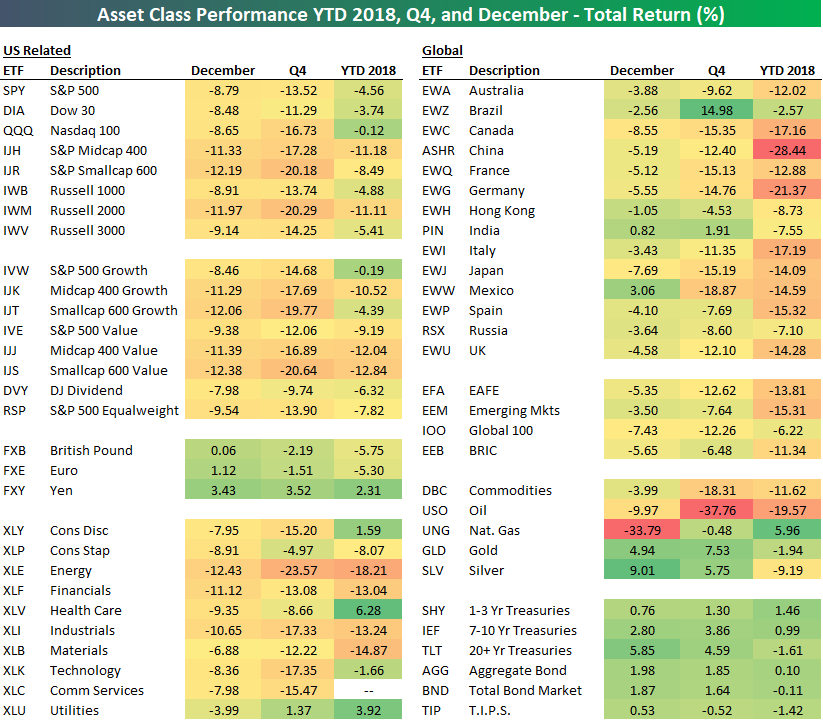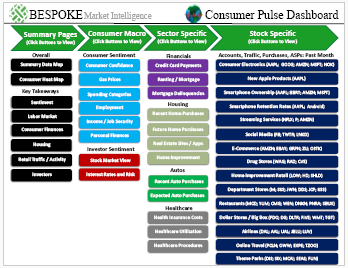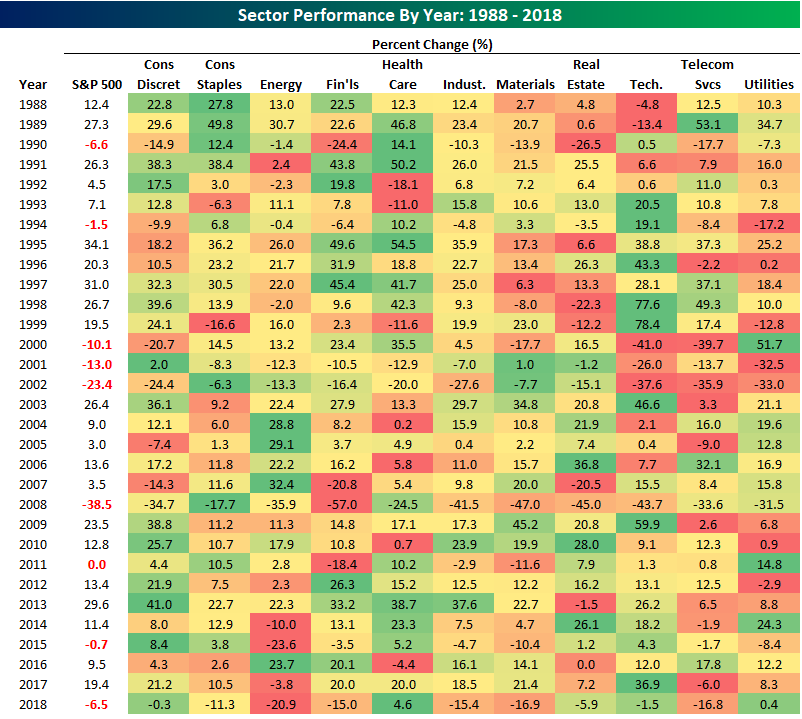2018 Asset Class Total Return Performance — Bespoke’s ETF Matrix
Below is a final look at 2018 total returns across asset classes using our ETF matrix. For each ETF, we show its December, Q4, and full year 2018 total return.
The S&P 500 (SPY) finished 2018 down 4.56% on a total return basis after falling 13.52% in Q4 and 8.79% in December. The tech-heavy Nasdaq 100 (QQQ) fell 0.12% on the year after dropping 16.73% in Q4. The small-cap Russell 2,000 (IWM) fell 11.11% on the year, while mid-caps (IJH) fell just a bit more at -11.18%. The Russell 2,000 was down more than 20% in Q4 alone.
Looking at sectors, Health Care (XLV) ended up performing the best in 2018 with a total return of +6.28%. Energy (XLE) was the biggest loser with a decline of 18.21%.
Outside of the US, China (ASHR) fell the most in 2018 with a drop of 28.44%. Germany (EWG) was the only other country in our matrix that fell more than 20% on the year. Brazil (EWZ) did the best with a decline of just 2.57% after rallying 14.98% in Q4.
The commodities ETF (DBC) was down 11.62% in 2018 due to oil’s drop of 19.57%. In Q4 alone, the oil ETF (USO) fell 37.76%. Precious metals helped counter oil’s Q4 declines by gaining 5%+. The gold ETF (GLD) was up 7.53% in Q4, which left it down 1.94% on the year.
Finally, Treasury ETFs rallied nicely in December and over the entire fourth quarter, but the “Total Bond Market” ETF (BND) still finished the year slightly in the red at -0.11%. The “Aggregate Bond” ETF (AGG) finished just barely in positive territory at +0.10%. The popular 20+ Year Treasury ETF (TLT) rose 5.85% in December, but it was still down 1.61% for the full year on a total return basis.
This Week’s Economic Indicators – 12/31/18
With holidays shortening this week and last, economic data has been rather hush. Last week only saw seven releases, four of which came in below expectations while only two beat. The two beats were the Chicago Fed National Activity index—the only release on Christmas Eve—and the Chicago PMI. While both were better than expected, they were, in fact, down from the prior period. Coming back from Christmas, we saw weaker home prices through the Case-Shiller Index. Perhaps the most surprising data release of the week was the much weaker reading in the Richmond Fed’s manufacturing data release.
Turning to this week, as the holidays come to a close, things pick back up although the first half of the week is still quiet. This morning, the Dallas Fed’s manufacturing activity continued the streak of weaker regional Fed data. There will be no releases on New Year’s Day and only one data point Wednesday. That one release is the Markit Manufacturing PMI which is expected to come in unchanged at 53.9; the services counterpart will come out later in the week and is also expected to be unchanged. Thursday and Friday completely make up for the lack of data with nearly 20 releases scheduled between the two days. Thursday kicks off with mortgage applications and ADP employment data ahead of the Friday Nonfarm Payrolls report for December. Later in the morning, ISM releases their manufacturing index which will likely be considerably weaker given the string of poor regional Fed data. We will also see vehicle sales data released throughout the day. As just mentioned, Friday’s Nonfarm Payrolls report will be the most widely watched indicator of the week, and its release will not be affected by the shutdown.
Bespoke Consumer Pulse Report — December 2018
Bespoke’s Consumer Pulse Report is an analysis of a huge consumer survey that we run each month. Our goal with this survey is to track trends across the economic and financial landscape in the US. Using the results from our proprietary monthly survey, we dissect and analyze all of the data and publish the Consumer Pulse Report, which we sell access to on a subscription basis. Sign up for a 30-day free trial to our Bespoke Consumer Pulse subscription service. With a trial, you’ll get coverage of consumer electronics, social media, streaming media, retail, autos, and much more. The report also has numerous proprietary US economic data points that are extremely timely and useful for investors.
We’ve just released our most recent monthly report to Pulse subscribers, and it’s definitely worth the read if you’re curious about the health of the consumer in the current market environment. Start a 30-day free trial for a full breakdown of all of our proprietary Pulse economic indicators.
2018 Sector Performance – Energy: Where Money Goes to Burn
There’s still a little bit more trading left in 2018, but between now and the closing bell, we wouldn’t expect much of a major shift in the final performance numbers for the major market sectors. The chart below shows the annual percentage change of the 11 S&P sectors by year in terms of price returns. Additionally, the shading for each sector represents how that sector performed relative to other sectors for that particular year. For example, in 2018 Energy was the worst performing sector with a decline of 20.9%, so it is shaded red, while Health Care, with a gain of 4.6%, has been the best performing sector, so it is shaded in green. The gap in performance between the best and worst performing sectors this year was 25.5 percentage points. While that may sound like a wide disparity between sectors, it is actually the narrowest performance gap between the best and worst performing sectors of any other year in the table! Last year, which was generally considered a year where everything traded higher, the performance gap was much wider at 42.9 percentage points as Technology rallied 36.9% while Telecom was down 6%.
Looking at recent trends in performance, one sector that stands out for its weakness is Energy. Over the last five years, the sector has been down for the year four times and been the worst performing sector in three of those years (2014, 2015, and 2018) and the second worst performing sector in the other (2017). While it was the best performing sector in the one year it was up (2016), since the end of 2013, it has been a sector where money goes to burn. To put the recent losses for the sector in perspective, over a period where the S&P 500 is up 31%, the Energy sector is down over 35%. Put another way, had you invested $100 in SPY at the end of 2013 ($131.15) you would now have more than twice the amount of money you would have if you had invested in XLE ($64.73). While the renaissance in US energy production has been great for the US economy, the companies actually involved in getting the stuff out of the ground have probably benefited the least.
What sector would have been the friendliest over that same time-span? That would be tech as $100 invested in XLK (the Technology sector ETF) would be worth close to $200 ($197.17) today. Times haven’t always been good for tech, though. The dark ages for the sector were from 2000 through 2002 when it lost 25% or more for three straight years. That’s a streak that no other sector can lay claim to, and the only sector that saw even back to back declines of 25%+ was Utilities. Yes, you read that right, the sector that is universally thought to be the most defensive sector in the market once saw a two-year stretch where it declined over 50%!
Chart of the Day: S&P 500 Performance On Last & First Trading Days
Morning Lineup – Closing on a High Note?
In a year that many investors are happy to see come to an end, US equities are looking to finish off 2018 on a positive note. Keep in mind, though, that there are still 7.5 hours between now and the closing bell. In today’s Morning Lineup, we discuss where we think this rally is going next in the short-term, China’s grim manufacturing data, and the dismal performance of equities around the world this year.
Read today’s Bespoke Morning Lineup below for major macro and stock-specific news events, updated market internals, and commentary.
Bespoke Morning Lineup – 12/31/18
We’ve discussed the market’s extreme oversold breadth readings a number of times here and in various reports over the last couple of weeks, but it really is hard to appreciate just how extreme things have been. Another case in point is the S&P 500’s 10-day A/D line. Readings below -1,500 in this indicator aren’t particularly common and usually don’t last long as they are indicative of deeply oversold markets.
Heading into today, though, this indicator has been below -1,500 for eight straight trading days. That’s nearly unheard of! In fact, the only two other times since 1990 that the indicator has been below -1,500 for as long were in September 2001 after the World Trade Center attacks and then in October 2008 in the middle of the Financial Crisis. Each of those periods is indicated with red dots on the chart below. While both occurred well into a major decline in equity prices, neither occurrence marked an actual low in the market.
Start a two-week free trial to Bespoke Premium to see today’s full Morning Lineup report. You’ll receive it in your inbox each morning an hour before the open to get your trading day started.
Bespoke Brunch Reads: 12/30/18
Welcome to Bespoke Brunch Reads — a linkfest of the favorite things we read over the past week. The links are mostly market related, but there are some other interesting subjects covered as well. We hope you enjoy the food for thought as a supplement to the research we provide you during the week.
While you’re here, join Bespoke Premium for 3 months for just $95 with our 2019 Annual Outlook special offer.
Genetics
Chinese Gene-Editing Experiment Loses Track of Patients, Alarming Technology’s Inventors by Preetika Rana and Wenxin Fan (WSJ)
Trials of a cutting edge gene editing technology in China have run at a break-neck pace, but the speed comes with consequences: losing touch with patients, side-effects, and other sloppy methodology that puts patients at risk. [Link; paywall]
Five Amazing Things We Learned About History From Ancient DNA In 2018 by Jennifer Raff (Forbes)
A run-down of the insights DNA offers into ancient populations and therefore history that dates back to a time we can’t usually see. [Link; auto-playing video]
Infrastructure
Swamped With Inventory, U.S. Companies Turn to ‘Mobile Storage’ by Erica E. Phillips (WSJ)
With trade flows disrupted and inventories overflowing from bottlenecks in specific ports and logistical hubs, companies are turning their transportation assets into mobile mini-warehouses. [Link; paywall]
Idaho lab protects US infrastructure from cyber attacks by Keith Ridler (AP)
A tour of the Idaho National Laboratory, a key research facility is running at a break-neck pace as funding for and experience with cybersecurity rushes to keep up with the rapid evolution of the US security infrastructure. [Link]
Wealth of the Nation
The Long Run Effects of De Jure Discrimination in the Credit Market: How Redlining Increased Crime by John Anders (Working Paper)
This draft paper analyzes the long-run effects of racist housing policies implemented during the New Deal, making a causal link between the practice of redlining and crime both within and across cities. [Link; 64 page PDF]
‘I see no way out’: Living paycheck to paycheck is disturbingly common by Danielle Paguette (Philly Inquirer/WaPo)
Four out of ten Americans reported they couldn’t fund a $400 emergency expense in 2017, a number consistent with Bespoke’s surveys which indicate roughly 40% of the country considers itself living “paycheck to paycheck”. [Link]
Messing With The Midwest
The Der Spiegel journalist who messed with the wrong small town by Michele Anderson and Jake Krohn (Spectator)
A German reporter from Der Spiegel journeyed to Minnesota to examine the soul of America, but his gross fabrications ended up getting him fired after a broader series of invented stories were revealed. This response from two residents is worthwhile. [Link]
Streaming
Netflix says a third of its global subscriber base watched ‘Bird Box’ in the original film’s first week by Sara Salinas (CNBC)
While comparing the success of a film on Netflix to those released through traditional venues, it’s clear that Bird Box was extremely popular, with more than 45 million views likely in the first week of its availability. [Link]
Fast Food
Should McDonald’s Serve Burgers In The Morning? by Jonathan Maze (Restaurant Business)
An analysis of the reasons that the Golden Arches won’t be offering you a Breakfast Big Mac any time soon, no matter how compelling demands might be on social media. [Link]
Charts
The 45 Best — And Weirdest — Charts We Made In 2018 (538)
Some clear, some confusing, these charts are a testament to the creativity of data journalists and a fun rundown of the year that was. [Link]
The Fed
Trump Discusses Firing Fed’s Powell After Latest Rate Hike, Sources Say by Jennifer Jacobs, Saleha Mohsin, and Margaret Talev (Bloomberg Quint)
Enraged that the Federal Reserve is raising interest rates, the President has discussed taking out his anger on the Fed Chair, a move for which he has dubious legal grounds and little political mandate. [Link; soft paywall]
Read Bespoke’s most actionable market research by joining Bespoke Premium today! Get started here.
Have a happy New Year!
Bespoke’s Sector Snapshot — 12/28/18
Bespoke CNBC Appearance (12/28)
Bespoke co-founder Paul Hickey appeared on CNBC’s Power Lunch today to discuss the current market and whether this week’s rally was a bottom or a bounce. To view the segment click on the image below.








